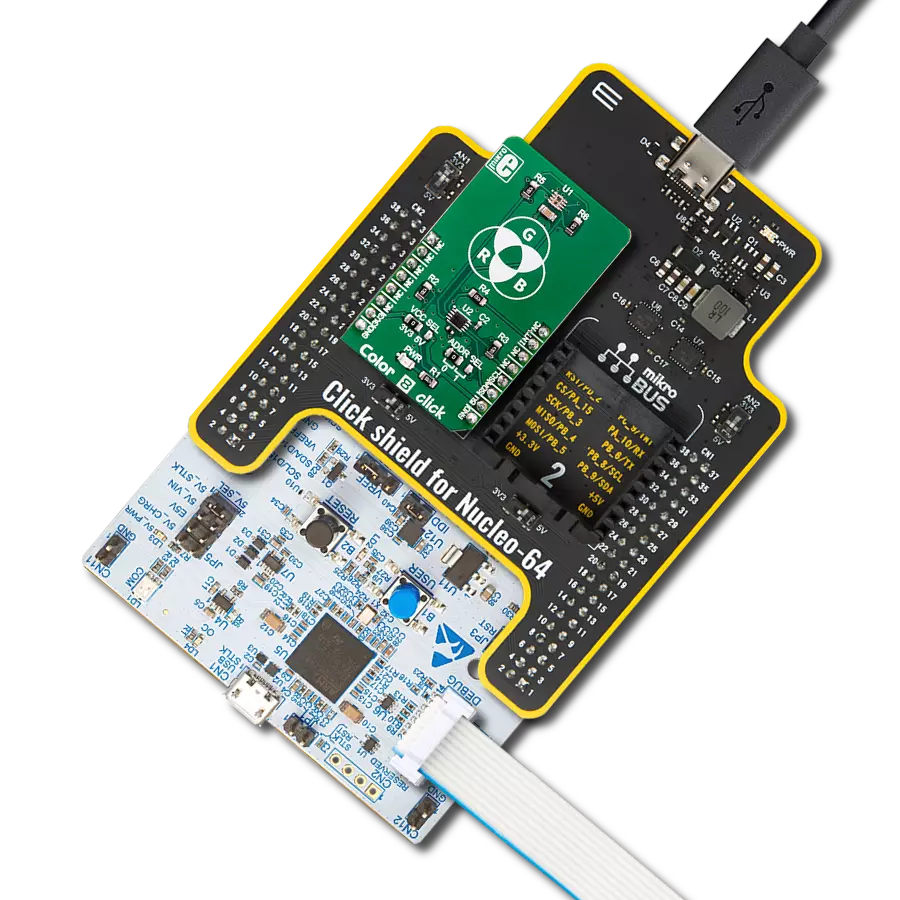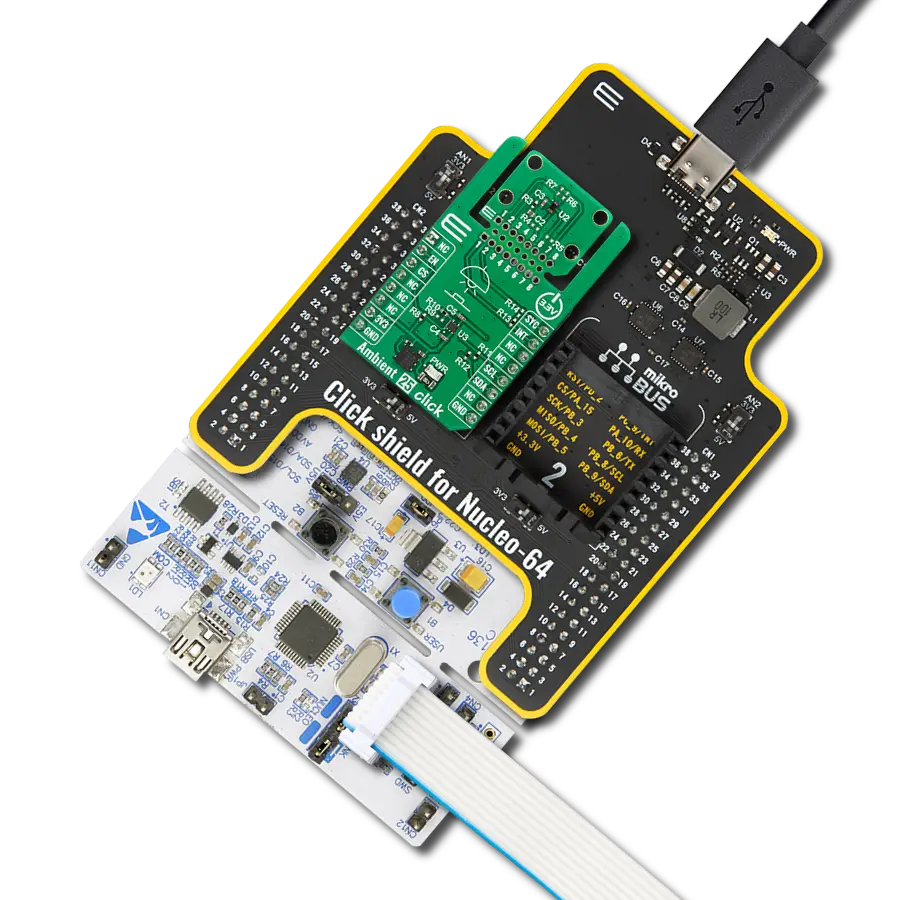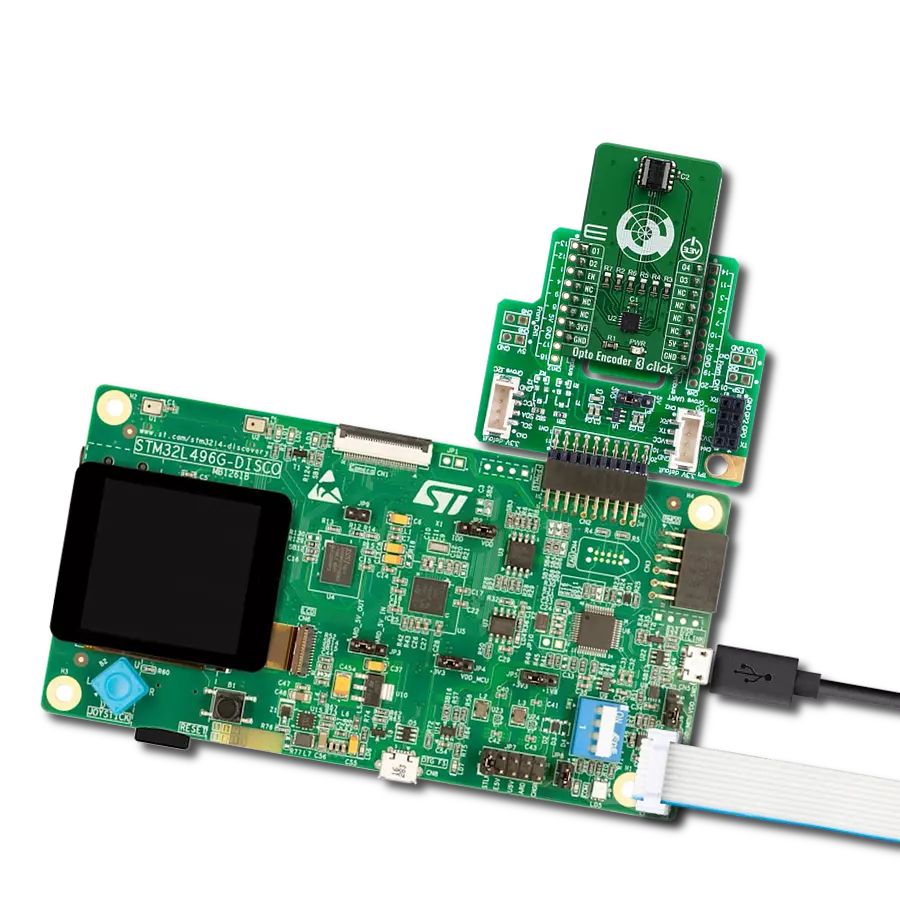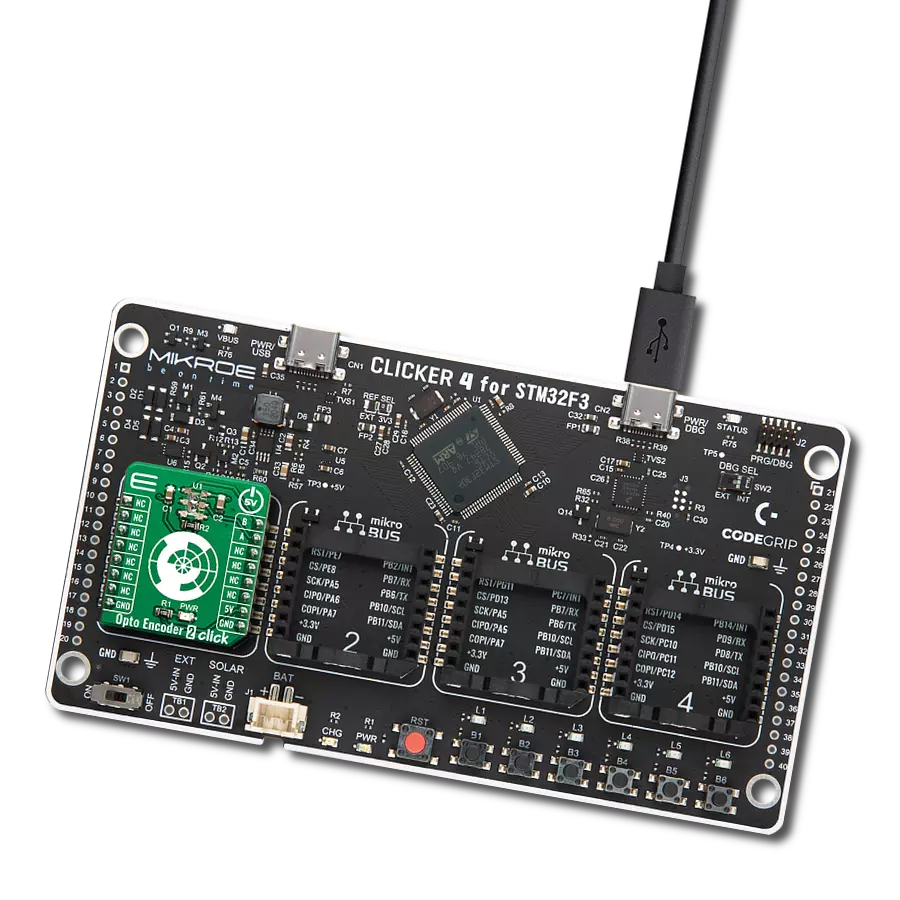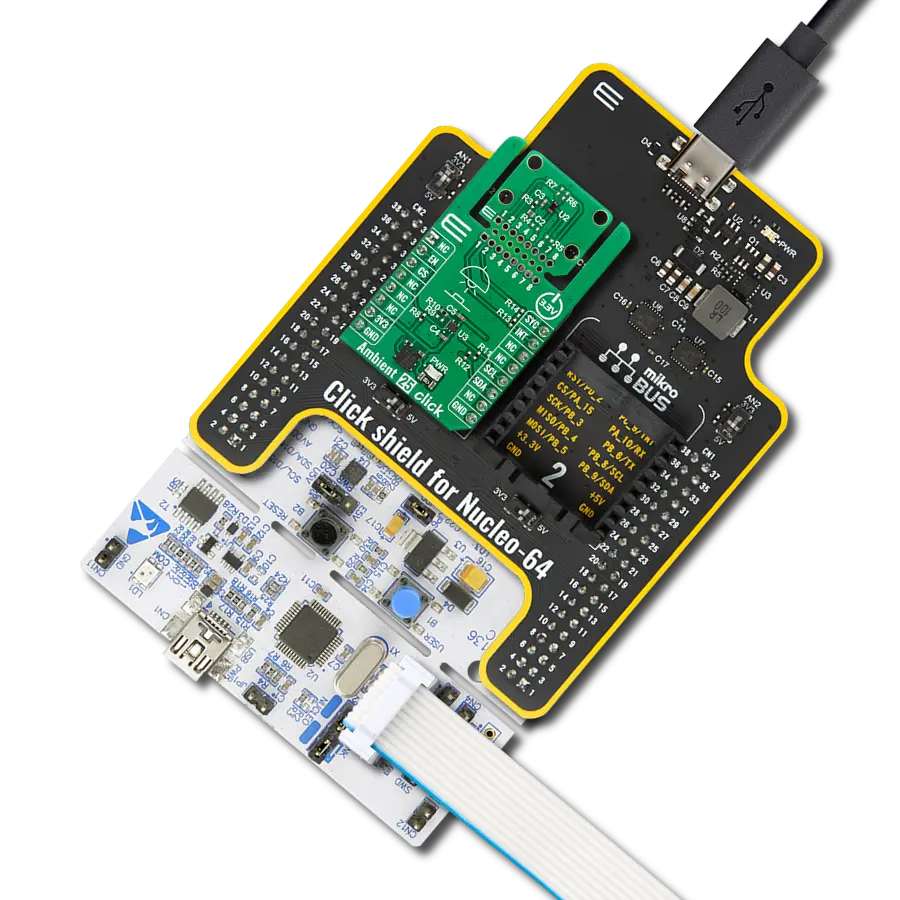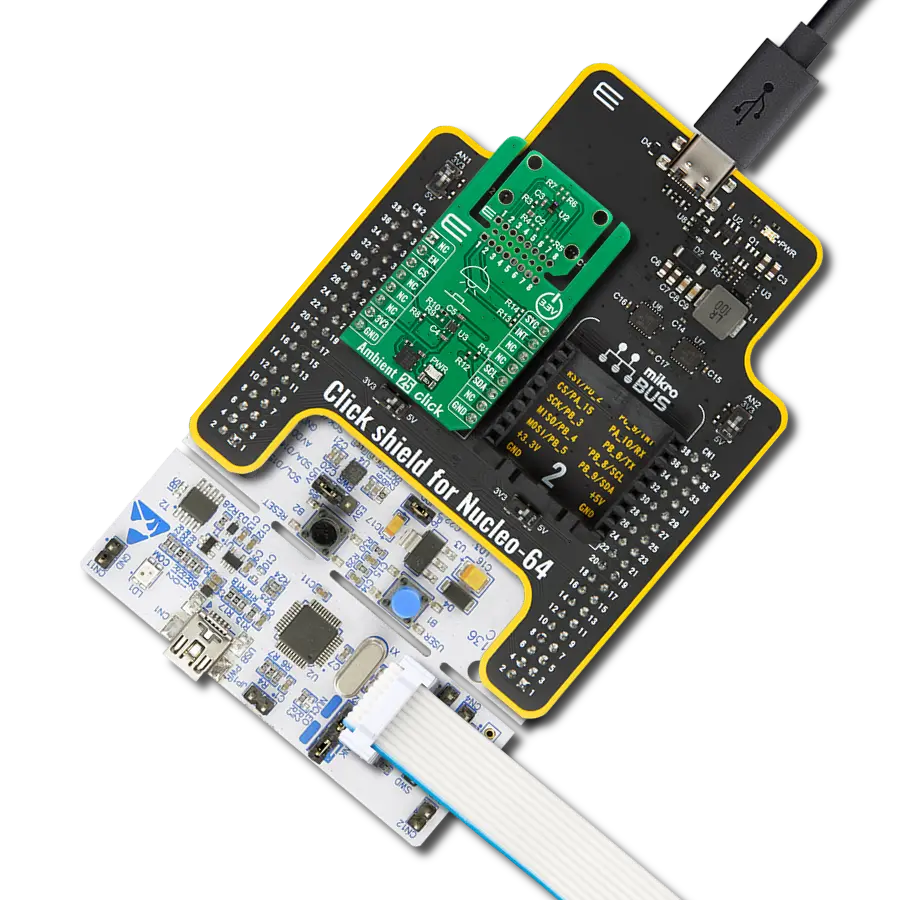Achieve fast and stable infrared data communication, covering a more than 1m range and speeds up to 115.2 kbit/s
A
A
Hardware Overview
How does it work?
IrDA 2 Click is based on the MCP2120, a high-performance fully-static infrared encoder/decoder from Microchip for sending and receiving IR serial data from the infrared transceiver module, the TFDU4101 from Vishay semiconductor. This way, the MCP2120 adds IR capability to any embedded application with serial data. The data from a standard UART is encoded (modulated) and output as electrical pulses to the IR Transceiver. Besides, the IR Transceiver also receives and outputs electrical pulses, which the MCP2120 decodes (demodulates) and transmits by the UART interface. The latest IrDAR physical layer standard performs this modulation and demodulation method for fast infrared data communication, supporting IrDA speeds up to 115.2kbit/s. Integrated within the TFDU4101 transceiver module is a photo pin diode, an infrared emitter (IRED), and a low-power control
IC to provide a total front-end solution in a single package. This Click board™ covers the full IrDA range of more than 1m and can be turned on or off through the EN pin routed to the CS pin of the mikroBUS™ socket; hence, offering a switch operation to turn ON/OFF power delivery to the MCP2120. The MCP2120 will encode and decode serial data at the selected data or baud rate. The selection can be made by positioning SMD jumpers labeled as BR SEL in an appropriate position marked as 1 or 0. Also, the software baud rate selection is selected if all these jumpers are in a high (1) position. For any other inputs, the hardware select mode is active. This setting is latched when the MCP2120 is reset from the RST pin of the mikroBUS™ socket. After an MCP2120 reset, changing the value of the baud pins does not affect the device’s baud rate. Software baud data
rate is intended for use with systems where switching data rates must be performed frequently between the MCP2120 and the embedded host. In software baud mode, the MCP2120 differentiates between data and commands. This feature is controlled via the MOD pin routed to the AN pin of the mikroBUS™ socket. The MOD pin is used to switch between command and data modes, and when the MOD pin is in a low state, the MCP2120 is in command mode; otherwise, the MCP2120 is in data mode. This Click board™ can operate with either 3.3V or 5V logic voltage levels selected via the PWR SEL jumper. This way, both 3.3V and 5V capable MCUs can use the communication lines properly. Also, this Click board™ comes equipped with a library containing easy-to-use functions and an example code that can be used as a reference for further development.
Features overview
Development board
Fusion for STM32 v8 is a development board specially designed for the needs of rapid development of embedded applications. It supports a wide range of microcontrollers, such as different 32-bit ARM® Cortex®-M based MCUs from STMicroelectronics, regardless of their number of pins, and a broad set of unique functions, such as the first-ever embedded debugger/programmer over WiFi. The development board is well organized and designed so that the end-user has all the necessary elements, such as switches, buttons, indicators, connectors, and others, in one place. Thanks to innovative manufacturing technology, Fusion for STM32 v8 provides a fluid and immersive working experience, allowing
access anywhere and under any circumstances at any time. Each part of the Fusion for STM32 v8 development board contains the components necessary for the most efficient operation of the same board. An advanced integrated CODEGRIP programmer/debugger module offers many valuable programming/debugging options, including support for JTAG, SWD, and SWO Trace (Single Wire Output)), and seamless integration with the Mikroe software environment. Besides, it also includes a clean and regulated power supply module for the development board. It can use a wide range of external power sources, including a battery, an external 12V power supply, and a power source via the USB Type-C (USB-C) connector.
Communication options such as USB-UART, USB HOST/DEVICE, CAN (on the MCU card, if supported), and Ethernet is also included. In addition, it also has the well-established mikroBUS™ standard, a standardized socket for the MCU card (SiBRAIN standard), and two display options for the TFT board line of products and character-based LCD. Fusion for STM32 v8 is an integral part of the Mikroe ecosystem for rapid development. Natively supported by Mikroe software tools, it covers many aspects of prototyping and development thanks to a considerable number of different Click boards™ (over a thousand boards), the number of which is growing every day.
Microcontroller Overview
MCU Card / MCU
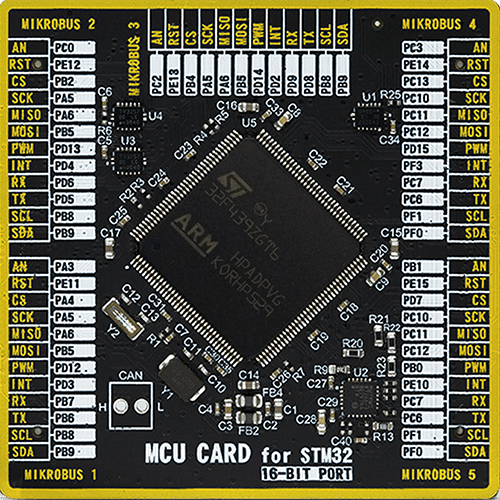
Type
8th Generation
Architecture
ARM Cortex-M4
MCU Memory (KB)
512
Silicon Vendor
STMicroelectronics
Pin count
144
RAM (Bytes)
131072
Used MCU Pins
mikroBUS™ mapper
Take a closer look
Click board™ Schematic

Step by step
Project assembly
Track your results in real time
Application Output
1. Application Output - In Debug mode, the 'Application Output' window enables real-time data monitoring, offering direct insight into execution results. Ensure proper data display by configuring the environment correctly using the provided tutorial.

2. UART Terminal - Use the UART Terminal to monitor data transmission via a USB to UART converter, allowing direct communication between the Click board™ and your development system. Configure the baud rate and other serial settings according to your project's requirements to ensure proper functionality. For step-by-step setup instructions, refer to the provided tutorial.

3. Plot Output - The Plot feature offers a powerful way to visualize real-time sensor data, enabling trend analysis, debugging, and comparison of multiple data points. To set it up correctly, follow the provided tutorial, which includes a step-by-step example of using the Plot feature to display Click board™ readings. To use the Plot feature in your code, use the function: plot(*insert_graph_name*, variable_name);. This is a general format, and it is up to the user to replace 'insert_graph_name' with the actual graph name and 'variable_name' with the parameter to be displayed.

Software Support
Library Description
This library contains API for IrDA 2 Click driver.
Key functions:
irda2_generic_write- This function writes a desired number of data bytes by using UART serial interfaceirda2_generic_read- This function reads a desired number of data bytes by using UART serial interfaceirda2_reset- This function executes a device reset operation
Open Source
Code example
The complete application code and a ready-to-use project are available through the NECTO Studio Package Manager for direct installation in the NECTO Studio. The application code can also be found on the MIKROE GitHub account.
/*!
* @file main.c
* @brief IrDA 2 Click Example.
*
* # Description
* This example demonstrates the use of an IrDA 2 Click board by showing
* the communication between the two Click boards.
*
* The demo application is composed of two sections :
*
* ## Application Init
* Initalizes device and makes an initial log.
*
* ## Application Task
* Depending on the selected application mode, it reads all the received data or
* sends the desired text message once per second.
*
* @author MikroE Team
*
*/
#include "board.h"
#include "log.h"
#include "irda2.h"
// Comment out the line below in order to switch the application mode to receiver
#define DEMO_APP_TRANSMITTER
// Text message to send in the transmitter application mode
#define DEMO_TEXT_MESSAGE "MIKROE - IrDA 2 Click board\r\n\0"
static irda2_t irda2;
static log_t logger;
void application_init ( void )
{
irda2_cfg_t irda2_cfg;
log_cfg_t logger_cfg;
/**
* Logger initialization.
* Default baud rate: 115200
* Default log level: LOG_LEVEL_DEBUG
* @note If USB_UART_RX and USB_UART_TX
* are defined as HAL_PIN_NC, you will
* need to define them manually for log to work.
* See @b LOG_MAP_USB_UART macro definition for detailed explanation.
*/
LOG_MAP_USB_UART( logger_cfg );
log_init( &logger, &logger_cfg );
log_info( &logger, " Application Init " );
// Click initialization.
irda2_cfg_setup( &irda2_cfg );
IRDA2_MAP_MIKROBUS( irda2_cfg, MIKROBUS_1 );
if ( UART_ERROR == irda2_init( &irda2, &irda2_cfg ) )
{
log_error( &logger, " Communication init." );
for ( ; ; );
}
irda2_default_cfg( &irda2 );
irda2_reset( &irda2 );
#ifdef DEMO_APP_TRANSMITTER
log_printf( &logger, " Application Mode: Transmitter\r\n" );
#else
log_printf( &logger, " Application Mode: Receiver\r\n" );
#endif
log_info( &logger, " Application Task " );
}
void application_task ( void )
{
#ifdef DEMO_APP_TRANSMITTER
irda2_generic_write( &irda2, DEMO_TEXT_MESSAGE, strlen( DEMO_TEXT_MESSAGE ) );
log_printf( &logger, "%s", ( char * ) DEMO_TEXT_MESSAGE );
Delay_ms ( 1000 );
#else
uint8_t rx_byte = 0;
if ( 1 == irda2_generic_read( &irda2, &rx_byte, 1 ) )
{
log_printf( &logger, "%c", rx_byte );
}
#endif
}
int main ( void )
{
/* Do not remove this line or clock might not be set correctly. */
#ifdef PREINIT_SUPPORTED
preinit();
#endif
application_init( );
for ( ; ; )
{
application_task( );
}
return 0;
}
// ------------------------------------------------------------------------ END
Additional Support
Resources
Category:Optical


















